2002 DODGE RAM engine oil capacity
[x] Cancel search: engine oil capacityPage 2123 of 2255
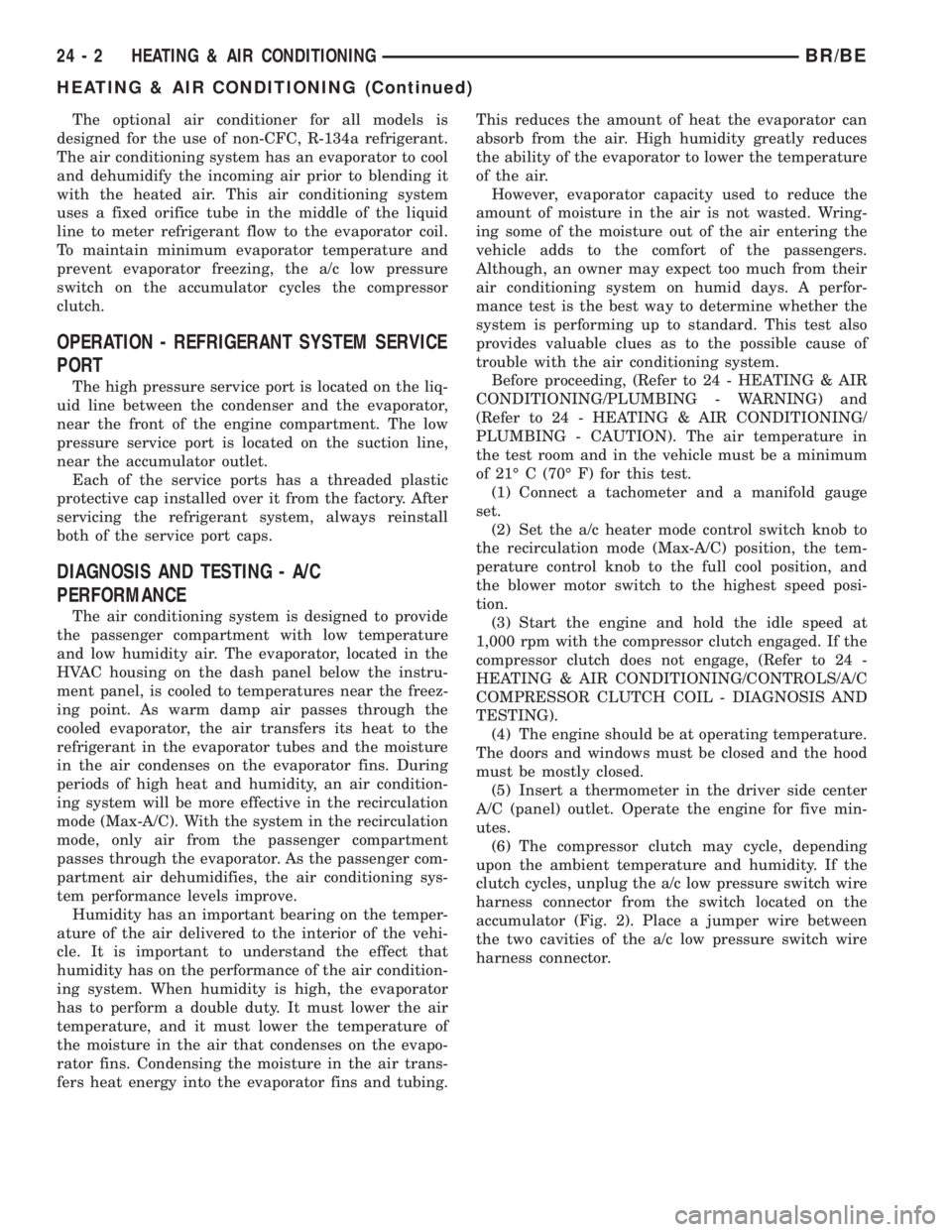
The optional air conditioner for all models is
designed for the use of non-CFC, R-134a refrigerant.
The air conditioning system has an evaporator to cool
and dehumidify the incoming air prior to blending it
with the heated air. This air conditioning system
uses a fixed orifice tube in the middle of the liquid
line to meter refrigerant flow to the evaporator coil.
To maintain minimum evaporator temperature and
prevent evaporator freezing, the a/c low pressure
switch on the accumulator cycles the compressor
clutch.
OPERATION - REFRIGERANT SYSTEM SERVICE
PORT
The high pressure service port is located on the liq-
uid line between the condenser and the evaporator,
near the front of the engine compartment. The low
pressure service port is located on the suction line,
near the accumulator outlet.
Each of the service ports has a threaded plastic
protective cap installed over it from the factory. After
servicing the refrigerant system, always reinstall
both of the service port caps.
DIAGNOSIS AND TESTING - A/C
PERFORMANCE
The air conditioning system is designed to provide
the passenger compartment with low temperature
and low humidity air. The evaporator, located in the
HVAC housing on the dash panel below the instru-
ment panel, is cooled to temperatures near the freez-
ing point. As warm damp air passes through the
cooled evaporator, the air transfers its heat to the
refrigerant in the evaporator tubes and the moisture
in the air condenses on the evaporator fins. During
periods of high heat and humidity, an air condition-
ing system will be more effective in the recirculation
mode (Max-A/C). With the system in the recirculation
mode, only air from the passenger compartment
passes through the evaporator. As the passenger com-
partment air dehumidifies, the air conditioning sys-
tem performance levels improve.
Humidity has an important bearing on the temper-
ature of the air delivered to the interior of the vehi-
cle. It is important to understand the effect that
humidity has on the performance of the air condition-
ing system. When humidity is high, the evaporator
has to perform a double duty. It must lower the air
temperature, and it must lower the temperature of
the moisture in the air that condenses on the evapo-
rator fins. Condensing the moisture in the air trans-
fers heat energy into the evaporator fins and tubing.This reduces the amount of heat the evaporator can
absorb from the air. High humidity greatly reduces
the ability of the evaporator to lower the temperature
of the air.
However, evaporator capacity used to reduce the
amount of moisture in the air is not wasted. Wring-
ing some of the moisture out of the air entering the
vehicle adds to the comfort of the passengers.
Although, an owner may expect too much from their
air conditioning system on humid days. A perfor-
mance test is the best way to determine whether the
system is performing up to standard. This test also
provides valuable clues as to the possible cause of
trouble with the air conditioning system.
Before proceeding, (Refer to 24 - HEATING & AIR
CONDITIONING/PLUMBING - WARNING) and
(Refer to 24 - HEATING & AIR CONDITIONING/
PLUMBING - CAUTION). The air temperature in
the test room and in the vehicle must be a minimum
of 21É C (70É F) for this test.
(1) Connect a tachometer and a manifold gauge
set.
(2) Set the a/c heater mode control switch knob to
the recirculation mode (Max-A/C) position, the tem-
perature control knob to the full cool position, and
the blower motor switch to the highest speed posi-
tion.
(3) Start the engine and hold the idle speed at
1,000 rpm with the compressor clutch engaged. If the
compressor clutch does not engage, (Refer to 24 -
HEATING & AIR CONDITIONING/CONTROLS/A/C
COMPRESSOR CLUTCH COIL - DIAGNOSIS AND
TESTING).
(4) The engine should be at operating temperature.
The doors and windows must be closed and the hood
must be mostly closed.
(5) Insert a thermometer in the driver side center
A/C (panel) outlet. Operate the engine for five min-
utes.
(6) The compressor clutch may cycle, depending
upon the ambient temperature and humidity. If the
clutch cycles, unplug the a/c low pressure switch wire
harness connector from the switch located on the
accumulator (Fig. 2). Place a jumper wire between
the two cavities of the a/c low pressure switch wire
harness connector.
24 - 2 HEATING & AIR CONDITIONINGBR/BE
HEATING & AIR CONDITIONING (Continued)
Page 2138 of 2255
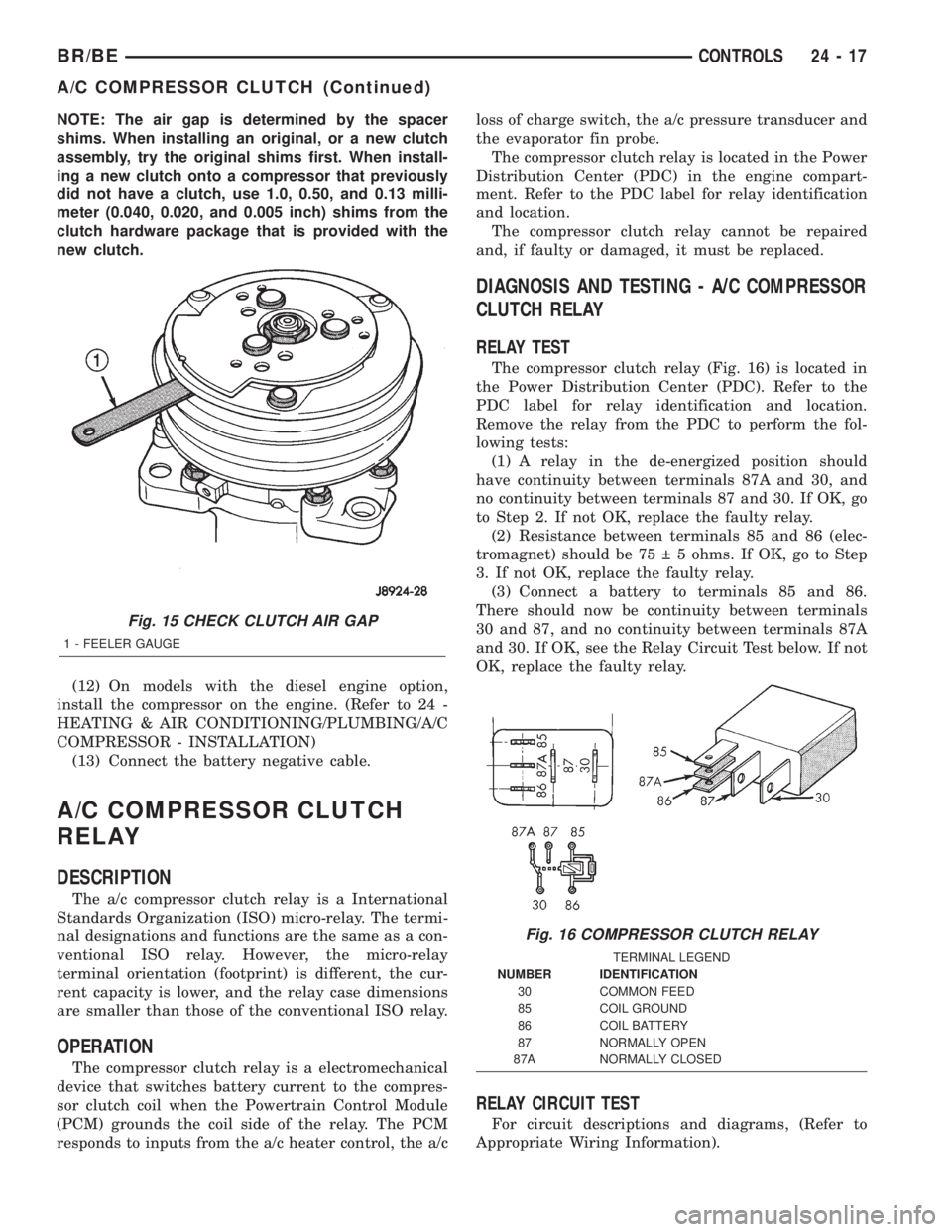
NOTE: The air gap is determined by the spacer
shims. When installing an original, or a new clutch
assembly, try the original shims first. When install-
ing a new clutch onto a compressor that previously
did not have a clutch, use 1.0, 0.50, and 0.13 milli-
meter (0.040, 0.020, and 0.005 inch) shims from the
clutch hardware package that is provided with the
new clutch.
(12) On models with the diesel engine option,
install the compressor on the engine. (Refer to 24 -
HEATING & AIR CONDITIONING/PLUMBING/A/C
COMPRESSOR - INSTALLATION)
(13) Connect the battery negative cable.
A/C COMPRESSOR CLUTCH
RELAY
DESCRIPTION
The a/c compressor clutch relay is a International
Standards Organization (ISO) micro-relay. The termi-
nal designations and functions are the same as a con-
ventional ISO relay. However, the micro-relay
terminal orientation (footprint) is different, the cur-
rent capacity is lower, and the relay case dimensions
are smaller than those of the conventional ISO relay.
OPERATION
The compressor clutch relay is a electromechanical
device that switches battery current to the compres-
sor clutch coil when the Powertrain Control Module
(PCM) grounds the coil side of the relay. The PCM
responds to inputs from the a/c heater control, the a/closs of charge switch, the a/c pressure transducer and
the evaporator fin probe.
The compressor clutch relay is located in the Power
Distribution Center (PDC) in the engine compart-
ment. Refer to the PDC label for relay identification
and location.
The compressor clutch relay cannot be repaired
and, if faulty or damaged, it must be replaced.
DIAGNOSIS AND TESTING - A/C COMPRESSOR
CLUTCH RELAY
RELAY TEST
The compressor clutch relay (Fig. 16) is located in
the Power Distribution Center (PDC). Refer to the
PDC label for relay identification and location.
Remove the relay from the PDC to perform the fol-
lowing tests:
(1) A relay in the de-energized position should
have continuity between terminals 87A and 30, and
no continuity between terminals 87 and 30. If OK, go
to Step 2. If not OK, replace the faulty relay.
(2) Resistance between terminals 85 and 86 (elec-
tromagnet) should be 75 5 ohms. If OK, go to Step
3. If not OK, replace the faulty relay.
(3) Connect a battery to terminals 85 and 86.
There should now be continuity between terminals
30 and 87, and no continuity between terminals 87A
and 30. If OK, see the Relay Circuit Test below. If not
OK, replace the faulty relay.
RELAY CIRCUIT TEST
For circuit descriptions and diagrams, (Refer to
Appropriate Wiring Information).
Fig. 15 CHECK CLUTCH AIR GAP
1 - FEELER GAUGE
Fig. 16 COMPRESSOR CLUTCH RELAY
TERMINAL LEGEND
NUMBER IDENTIFICATION
30 COMMON FEED
85 COIL GROUND
86 COIL BATTERY
87 NORMALLY OPEN
87A NORMALLY CLOSED
BR/BECONTROLS 24 - 17
A/C COMPRESSOR CLUTCH (Continued)
Page 2164 of 2255
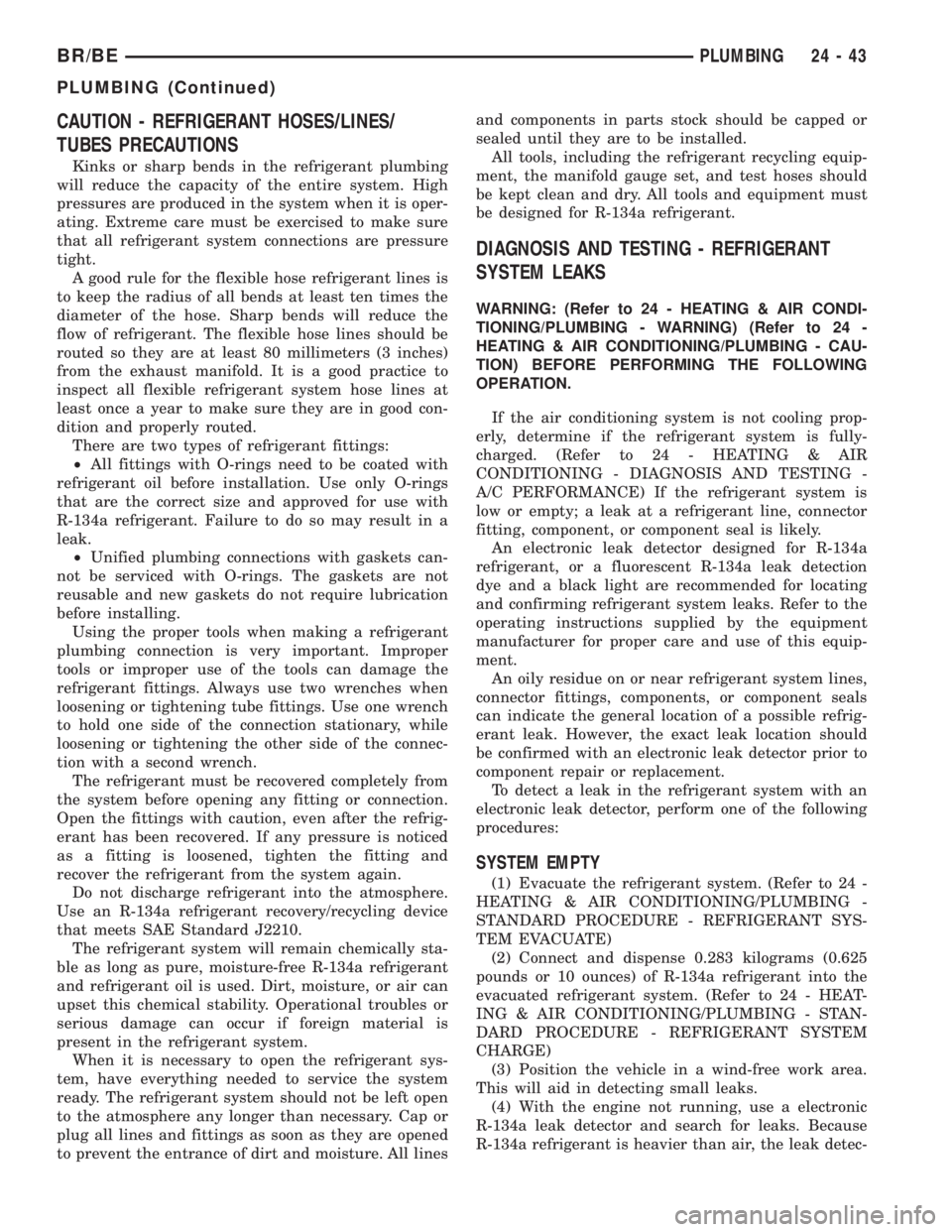
CAUTION - REFRIGERANT HOSES/LINES/
TUBES PRECAUTIONS
Kinks or sharp bends in the refrigerant plumbing
will reduce the capacity of the entire system. High
pressures are produced in the system when it is oper-
ating. Extreme care must be exercised to make sure
that all refrigerant system connections are pressure
tight.
A good rule for the flexible hose refrigerant lines is
to keep the radius of all bends at least ten times the
diameter of the hose. Sharp bends will reduce the
flow of refrigerant. The flexible hose lines should be
routed so they are at least 80 millimeters (3 inches)
from the exhaust manifold. It is a good practice to
inspect all flexible refrigerant system hose lines at
least once a year to make sure they are in good con-
dition and properly routed.
There are two types of refrigerant fittings:
²All fittings with O-rings need to be coated with
refrigerant oil before installation. Use only O-rings
that are the correct size and approved for use with
R-134a refrigerant. Failure to do so may result in a
leak.
²Unified plumbing connections with gaskets can-
not be serviced with O-rings. The gaskets are not
reusable and new gaskets do not require lubrication
before installing.
Using the proper tools when making a refrigerant
plumbing connection is very important. Improper
tools or improper use of the tools can damage the
refrigerant fittings. Always use two wrenches when
loosening or tightening tube fittings. Use one wrench
to hold one side of the connection stationary, while
loosening or tightening the other side of the connec-
tion with a second wrench.
The refrigerant must be recovered completely from
the system before opening any fitting or connection.
Open the fittings with caution, even after the refrig-
erant has been recovered. If any pressure is noticed
as a fitting is loosened, tighten the fitting and
recover the refrigerant from the system again.
Do not discharge refrigerant into the atmosphere.
Use an R-134a refrigerant recovery/recycling device
that meets SAE Standard J2210.
The refrigerant system will remain chemically sta-
ble as long as pure, moisture-free R-134a refrigerant
and refrigerant oil is used. Dirt, moisture, or air can
upset this chemical stability. Operational troubles or
serious damage can occur if foreign material is
present in the refrigerant system.
When it is necessary to open the refrigerant sys-
tem, have everything needed to service the system
ready. The refrigerant system should not be left open
to the atmosphere any longer than necessary. Cap or
plug all lines and fittings as soon as they are opened
to prevent the entrance of dirt and moisture. All linesand components in parts stock should be capped or
sealed until they are to be installed.
All tools, including the refrigerant recycling equip-
ment, the manifold gauge set, and test hoses should
be kept clean and dry. All tools and equipment must
be designed for R-134a refrigerant.
DIAGNOSIS AND TESTING - REFRIGERANT
SYSTEM LEAKS
WARNING: (Refer to 24 - HEATING & AIR CONDI-
TIONING/PLUMBING - WARNING) (Refer to 24 -
HEATING & AIR CONDITIONING/PLUMBING - CAU-
TION) BEFORE PERFORMING THE FOLLOWING
OPERATION.
If the air conditioning system is not cooling prop-
erly, determine if the refrigerant system is fully-
charged. (Refer to 24 - HEATING & AIR
CONDITIONING - DIAGNOSIS AND TESTING -
A/C PERFORMANCE) If the refrigerant system is
low or empty; a leak at a refrigerant line, connector
fitting, component, or component seal is likely.
An electronic leak detector designed for R-134a
refrigerant, or a fluorescent R-134a leak detection
dye and a black light are recommended for locating
and confirming refrigerant system leaks. Refer to the
operating instructions supplied by the equipment
manufacturer for proper care and use of this equip-
ment.
An oily residue on or near refrigerant system lines,
connector fittings, components, or component seals
can indicate the general location of a possible refrig-
erant leak. However, the exact leak location should
be confirmed with an electronic leak detector prior to
component repair or replacement.
To detect a leak in the refrigerant system with an
electronic leak detector, perform one of the following
procedures:
SYSTEM EMPTY
(1) Evacuate the refrigerant system. (Refer to 24 -
HEATING & AIR CONDITIONING/PLUMBING -
STANDARD PROCEDURE - REFRIGERANT SYS-
TEM EVACUATE)
(2) Connect and dispense 0.283 kilograms (0.625
pounds or 10 ounces) of R-134a refrigerant into the
evacuated refrigerant system. (Refer to 24 - HEAT-
ING & AIR CONDITIONING/PLUMBING - STAN-
DARD PROCEDURE - REFRIGERANT SYSTEM
CHARGE)
(3) Position the vehicle in a wind-free work area.
This will aid in detecting small leaks.
(4) With the engine not running, use a electronic
R-134a leak detector and search for leaks. Because
R-134a refrigerant is heavier than air, the leak detec-
BR/BEPLUMBING 24 - 43
PLUMBING (Continued)
Page 2167 of 2255

STANDARD PROCEDURE - REFRIGERANT
SYSTEM EVACUATE
WARNING: REVIEW THE WARNINGS AND CAU-
TIONS IN THE FRONT OF THIS SECTION BEFORE
PERFORMING THE FOLLOWING OPERATION.
(Refer to 24 - HEATING & AIR CONDITIONING/
PLUMBING - WARNING) (Refer to 24 - HEATING &
AIR CONDITIONING/PLUMBING - CAUTION)
If the refrigerant system has been open to the
atmosphere, it must be evacuated before the system
can be charged. If moisture and air enters the system
and becomes mixed with the refrigerant, the com-
pressor head pressure will rise above acceptable
operating levels. This will reduce the performance of
the air conditioner and damage the compressor.
Evacuating the refrigerant system will remove the
air and boil the moisture out of the system at near
room temperature. To evacuate the refrigerant sys-
tem, use the following procedure:
(1) Connect a R-134a refrigerant recovery/recy-
cling/charging station that meets SAE Standard
J2210 and a manifold gauge set to the refrigerant
system of the vehicle.
(2) Open the low and high side valves and start
the charging station vacuum pump. When the suc-
tion gauge reads 88 kPa (26 in. Hg.) vacuum or
greater, close all of the valves and turn off the vac-
uum pump.
(a) If the refrigerant system fails to reach the
specified vacuum, the system has a leak that must
be corrected. (Refer to 24 - HEATING & AIR CON-
DITIONING/PLUMBING - DIAGNOSIS AND
TESTING - REFRIGERANT SYSTEM LEAKS)
(b) If the refrigerant system maintains the spec-
ified vacuum for five minutes, restart the vacuum
pump, open the suction and discharge valves and
evacuate the system for an additional ten minutes.
(3) Close all of the valves, and turn off the charg-
ing station vacuum pump.
(4) The refrigerant system is now ready to be
charged with R-134a refrigerant. (Refer to 24 -
HEATING & AIR CONDITIONING/PLUMBING -
STANDARD PROCEDURE - REFRIGERANT SYS-
TEM CHARGE)
STANDARD PROCEDURE - REFRIGERANT
SYSTEM CHARGE
WARNING: REVIEW THE WARNINGS AND CAU-
TIONS IN THE FRONT OF THIS SECTION BEFORE
PERFORMING THE FOLLOWING OPERATION.
(Refer to 24 - HEATING & AIR CONDITIONING/
PLUMBING - WARNING) (Refer to 24 - HEATING &
AIR CONDITIONING/PLUMBING - CAUTION)After the refrigerant system has been tested for
leaks and evacuated, a refrigerant charge can be
injected into the system. (Refer to 24 - HEATING &
AIR CONDITIONING/PLUMBING - SPECIFICA-
TIONS - CHARGE CAPACITY)
A R-134a refrigerant recovery/recycling/charging
station that meets SAE Standard J2210 must be
used to charge the refrigerant system with R-134a
refrigerant. Refer to the operating instructions sup-
plied by the equipment manufacturer for proper care
and use of this equipment.
SPECIFICATIONS
SPECIFICATIONS
The R-134a refrigerant system charge capacity for
this vehicle is: 0.907 kilograms (32 ounces).
A/C COMPRESSOR
DESCRIPTION
The air conditioning system uses a Sanden
SD7H15 seven cylinder, reciprocating wobble plate-
type compressor on all models. This compressor has a
fixed displacement of 150 cubic centimeters (9.375
cubic inches), and has both the suction and discharge
ports located on the cylinder head. A label identifying
the use of R-134a refrigerant is located on the com-
pressor.
DESCRIPTION - HIGH PRESSURE RELIEF
VALVE
A high pressure relief valve is located on the com-
pressor cylinder head, which is at the rear of the
compressor. This mechanical valve is designed to
vent refrigerant from the system to protect against
damage to the compressor and other system compo-
nents, caused by condenser air flow restriction or an
overcharge of refrigerant.
OPERATION
The compressor is driven by the engine through an
electric clutch, drive pulley and belt arrangement.
The compressor is lubricated by refrigerant oil that is
circulated throughout the refrigerant system with the
refrigerant.
The compressor draws in low-pressure refrigerant
vapor from the evaporator through its suction port. It
then compresses the refrigerant into a high-pressure,
high-temperature refrigerant vapor, which is then
pumped to the condenser through the compressor dis-
charge port.
The compressor cannot be repaired. If faulty or
damaged, the entire compressor assembly must be
24 - 46 PLUMBINGBR/BE
PLUMBING (Continued)
Page 2168 of 2255
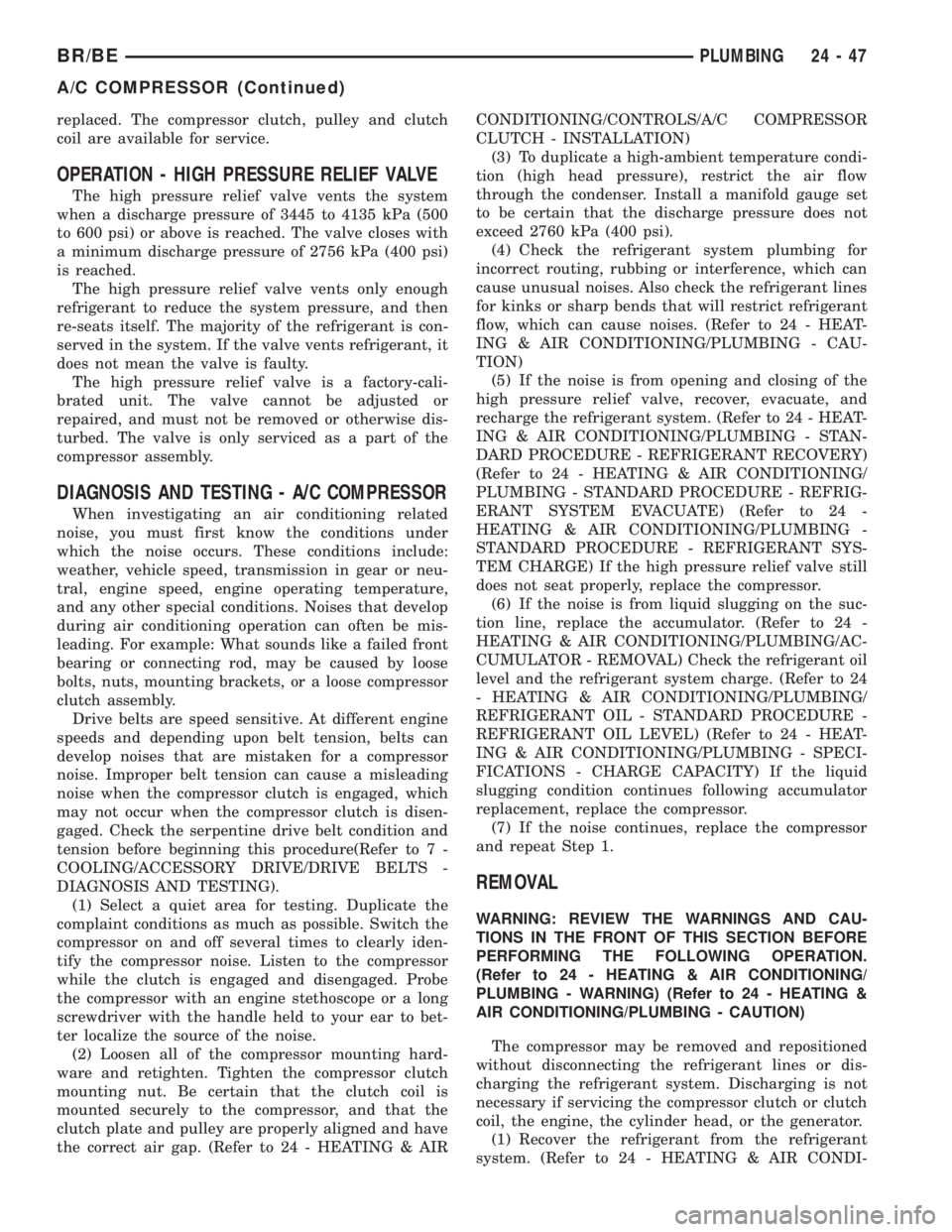
replaced. The compressor clutch, pulley and clutch
coil are available for service.
OPERATION - HIGH PRESSURE RELIEF VALVE
The high pressure relief valve vents the system
when a discharge pressure of 3445 to 4135 kPa (500
to 600 psi) or above is reached. The valve closes with
a minimum discharge pressure of 2756 kPa (400 psi)
is reached.
The high pressure relief valve vents only enough
refrigerant to reduce the system pressure, and then
re-seats itself. The majority of the refrigerant is con-
served in the system. If the valve vents refrigerant, it
does not mean the valve is faulty.
The high pressure relief valve is a factory-cali-
brated unit. The valve cannot be adjusted or
repaired, and must not be removed or otherwise dis-
turbed. The valve is only serviced as a part of the
compressor assembly.
DIAGNOSIS AND TESTING - A/C COMPRESSOR
When investigating an air conditioning related
noise, you must first know the conditions under
which the noise occurs. These conditions include:
weather, vehicle speed, transmission in gear or neu-
tral, engine speed, engine operating temperature,
and any other special conditions. Noises that develop
during air conditioning operation can often be mis-
leading. For example: What sounds like a failed front
bearing or connecting rod, may be caused by loose
bolts, nuts, mounting brackets, or a loose compressor
clutch assembly.
Drive belts are speed sensitive. At different engine
speeds and depending upon belt tension, belts can
develop noises that are mistaken for a compressor
noise. Improper belt tension can cause a misleading
noise when the compressor clutch is engaged, which
may not occur when the compressor clutch is disen-
gaged. Check the serpentine drive belt condition and
tension before beginning this procedure(Refer to 7 -
COOLING/ACCESSORY DRIVE/DRIVE BELTS -
DIAGNOSIS AND TESTING).
(1) Select a quiet area for testing. Duplicate the
complaint conditions as much as possible. Switch the
compressor on and off several times to clearly iden-
tify the compressor noise. Listen to the compressor
while the clutch is engaged and disengaged. Probe
the compressor with an engine stethoscope or a long
screwdriver with the handle held to your ear to bet-
ter localize the source of the noise.
(2) Loosen all of the compressor mounting hard-
ware and retighten. Tighten the compressor clutch
mounting nut. Be certain that the clutch coil is
mounted securely to the compressor, and that the
clutch plate and pulley are properly aligned and have
the correct air gap. (Refer to 24 - HEATING & AIRCONDITIONING/CONTROLS/A/C COMPRESSOR
CLUTCH - INSTALLATION)
(3) To duplicate a high-ambient temperature condi-
tion (high head pressure), restrict the air flow
through the condenser. Install a manifold gauge set
to be certain that the discharge pressure does not
exceed 2760 kPa (400 psi).
(4) Check the refrigerant system plumbing for
incorrect routing, rubbing or interference, which can
cause unusual noises. Also check the refrigerant lines
for kinks or sharp bends that will restrict refrigerant
flow, which can cause noises. (Refer to 24 - HEAT-
ING & AIR CONDITIONING/PLUMBING - CAU-
TION)
(5) If the noise is from opening and closing of the
high pressure relief valve, recover, evacuate, and
recharge the refrigerant system. (Refer to 24 - HEAT-
ING & AIR CONDITIONING/PLUMBING - STAN-
DARD PROCEDURE - REFRIGERANT RECOVERY)
(Refer to 24 - HEATING & AIR CONDITIONING/
PLUMBING - STANDARD PROCEDURE - REFRIG-
ERANT SYSTEM EVACUATE) (Refer to 24 -
HEATING & AIR CONDITIONING/PLUMBING -
STANDARD PROCEDURE - REFRIGERANT SYS-
TEM CHARGE) If the high pressure relief valve still
does not seat properly, replace the compressor.
(6) If the noise is from liquid slugging on the suc-
tion line, replace the accumulator. (Refer to 24 -
HEATING & AIR CONDITIONING/PLUMBING/AC-
CUMULATOR - REMOVAL) Check the refrigerant oil
level and the refrigerant system charge. (Refer to 24
- HEATING & AIR CONDITIONING/PLUMBING/
REFRIGERANT OIL - STANDARD PROCEDURE -
REFRIGERANT OIL LEVEL) (Refer to 24 - HEAT-
ING & AIR CONDITIONING/PLUMBING - SPECI-
FICATIONS - CHARGE CAPACITY) If the liquid
slugging condition continues following accumulator
replacement, replace the compressor.
(7) If the noise continues, replace the compressor
and repeat Step 1.
REMOVAL
WARNING: REVIEW THE WARNINGS AND CAU-
TIONS IN THE FRONT OF THIS SECTION BEFORE
PERFORMING THE FOLLOWING OPERATION.
(Refer to 24 - HEATING & AIR CONDITIONING/
PLUMBING - WARNING) (Refer to 24 - HEATING &
AIR CONDITIONING/PLUMBING - CAUTION)
The compressor may be removed and repositioned
without disconnecting the refrigerant lines or dis-
charging the refrigerant system. Discharging is not
necessary if servicing the compressor clutch or clutch
coil, the engine, the cylinder head, or the generator.
(1) Recover the refrigerant from the refrigerant
system. (Refer to 24 - HEATING & AIR CONDI-
BR/BEPLUMBING 24 - 47
A/C COMPRESSOR (Continued)
Page 2178 of 2255
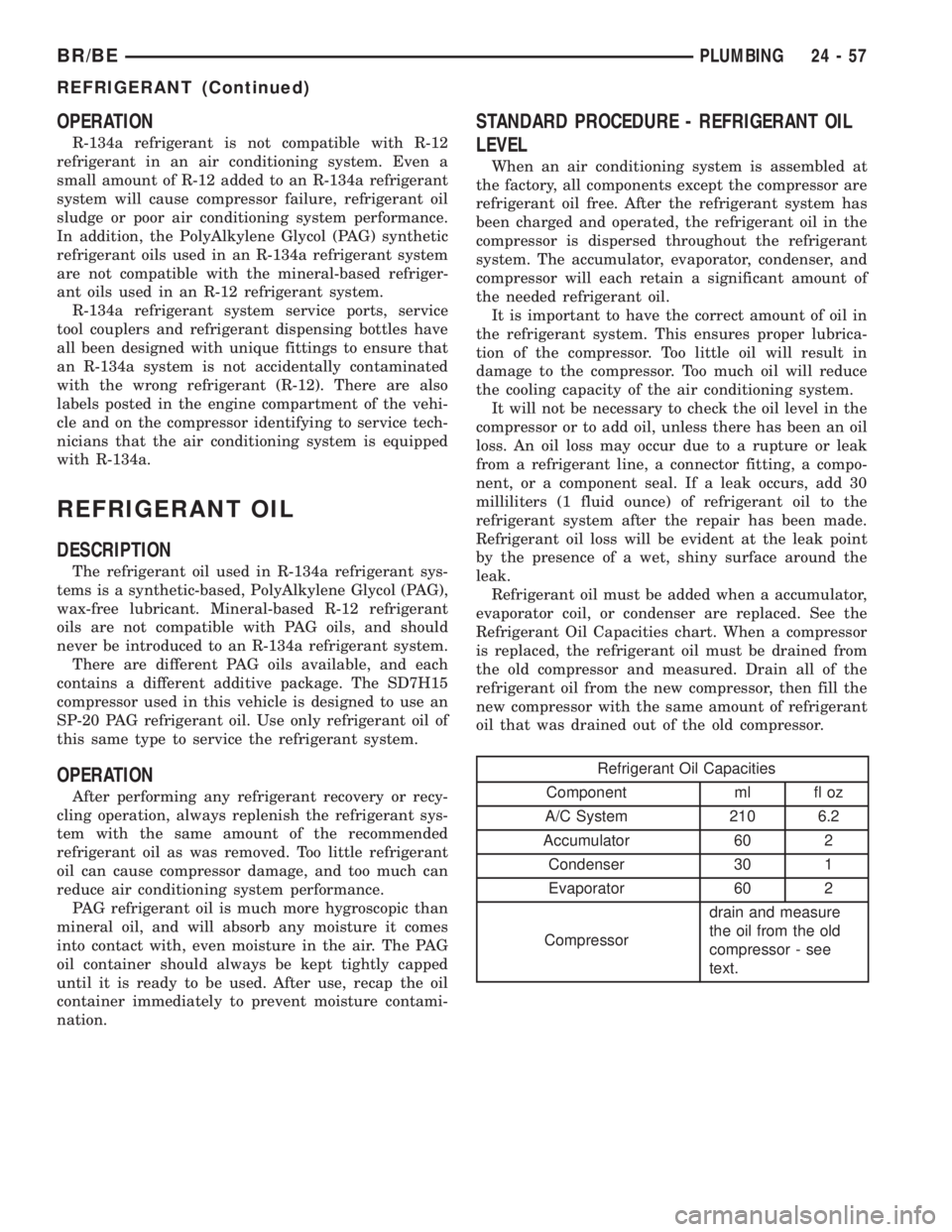
OPERATION
R-134a refrigerant is not compatible with R-12
refrigerant in an air conditioning system. Even a
small amount of R-12 added to an R-134a refrigerant
system will cause compressor failure, refrigerant oil
sludge or poor air conditioning system performance.
In addition, the PolyAlkylene Glycol (PAG) synthetic
refrigerant oils used in an R-134a refrigerant system
are not compatible with the mineral-based refriger-
ant oils used in an R-12 refrigerant system.
R-134a refrigerant system service ports, service
tool couplers and refrigerant dispensing bottles have
all been designed with unique fittings to ensure that
an R-134a system is not accidentally contaminated
with the wrong refrigerant (R-12). There are also
labels posted in the engine compartment of the vehi-
cle and on the compressor identifying to service tech-
nicians that the air conditioning system is equipped
with R-134a.
REFRIGERANT OIL
DESCRIPTION
The refrigerant oil used in R-134a refrigerant sys-
tems is a synthetic-based, PolyAlkylene Glycol (PAG),
wax-free lubricant. Mineral-based R-12 refrigerant
oils are not compatible with PAG oils, and should
never be introduced to an R-134a refrigerant system.
There are different PAG oils available, and each
contains a different additive package. The SD7H15
compressor used in this vehicle is designed to use an
SP-20 PAG refrigerant oil. Use only refrigerant oil of
this same type to service the refrigerant system.
OPERATION
After performing any refrigerant recovery or recy-
cling operation, always replenish the refrigerant sys-
tem with the same amount of the recommended
refrigerant oil as was removed. Too little refrigerant
oil can cause compressor damage, and too much can
reduce air conditioning system performance.
PAG refrigerant oil is much more hygroscopic than
mineral oil, and will absorb any moisture it comes
into contact with, even moisture in the air. The PAG
oil container should always be kept tightly capped
until it is ready to be used. After use, recap the oil
container immediately to prevent moisture contami-
nation.
STANDARD PROCEDURE - REFRIGERANT OIL
LEVEL
When an air conditioning system is assembled at
the factory, all components except the compressor are
refrigerant oil free. After the refrigerant system has
been charged and operated, the refrigerant oil in the
compressor is dispersed throughout the refrigerant
system. The accumulator, evaporator, condenser, and
compressor will each retain a significant amount of
the needed refrigerant oil.
It is important to have the correct amount of oil in
the refrigerant system. This ensures proper lubrica-
tion of the compressor. Too little oil will result in
damage to the compressor. Too much oil will reduce
the cooling capacity of the air conditioning system.
It will not be necessary to check the oil level in the
compressor or to add oil, unless there has been an oil
loss. An oil loss may occur due to a rupture or leak
from a refrigerant line, a connector fitting, a compo-
nent, or a component seal. If a leak occurs, add 30
milliliters (1 fluid ounce) of refrigerant oil to the
refrigerant system after the repair has been made.
Refrigerant oil loss will be evident at the leak point
by the presence of a wet, shiny surface around the
leak.
Refrigerant oil must be added when a accumulator,
evaporator coil, or condenser are replaced. See the
Refrigerant Oil Capacities chart. When a compressor
is replaced, the refrigerant oil must be drained from
the old compressor and measured. Drain all of the
refrigerant oil from the new compressor, then fill the
new compressor with the same amount of refrigerant
oil that was drained out of the old compressor.
Refrigerant Oil Capacities
Component ml fl oz
A/C System 210 6.2
Accumulator 60 2
Condenser 30 1
Evaporator 60 2
Compressordrain and measure
the oil from the old
compressor - see
text.
BR/BEPLUMBING 24 - 57
REFRIGERANT (Continued)
Page 2231 of 2255
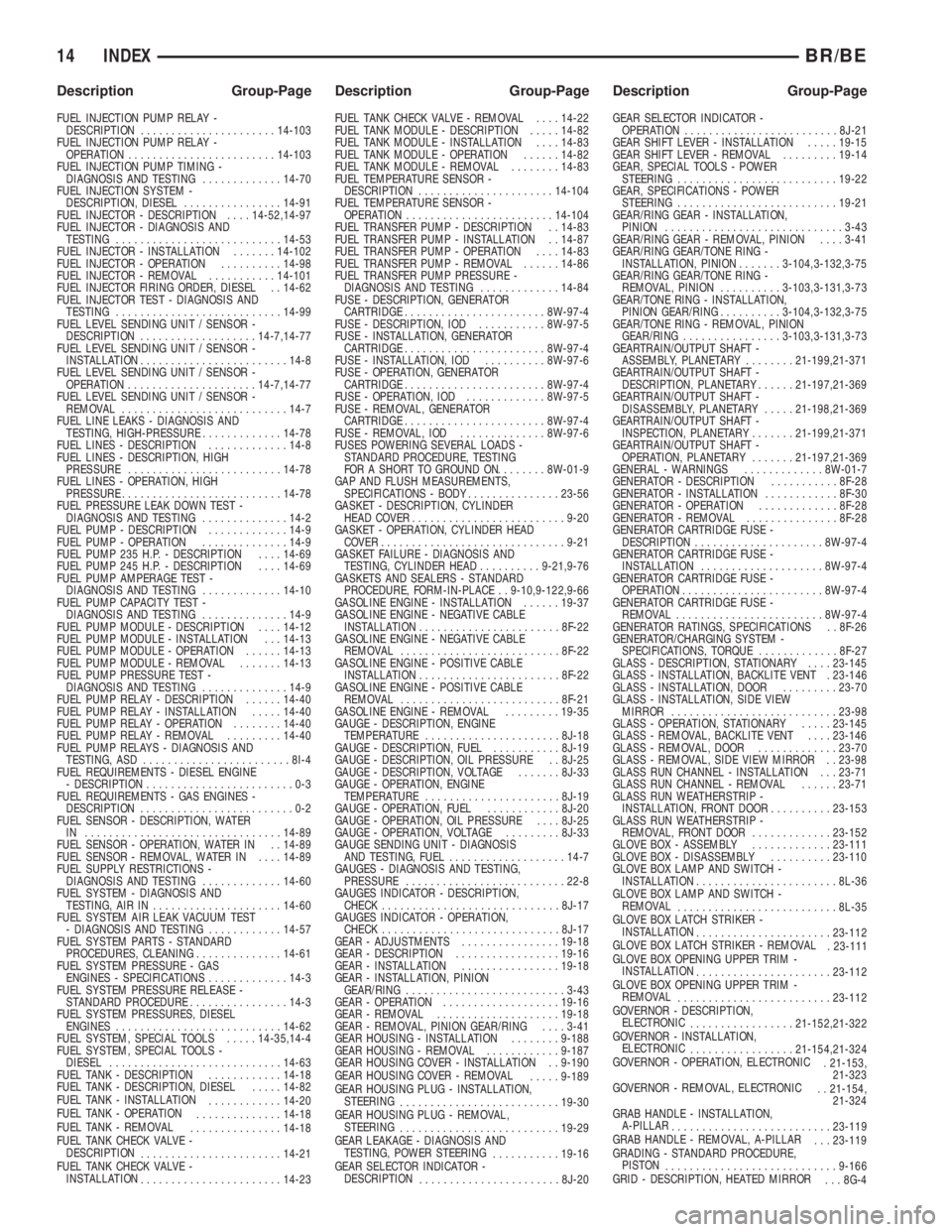
FUEL INJECTION PUMP RELAY -
DESCRIPTION......................14-103
FUEL INJECTION PUMP RELAY -
OPERATION........................14-103
FUEL INJECTION PUMP TIMING -
DIAGNOSIS AND TESTING.............14-70
FUEL INJECTION SYSTEM -
DESCRIPTION, DIESEL................14-91
FUEL INJECTOR - DESCRIPTION....14-52,14-97
FUEL INJECTOR - DIAGNOSIS AND
TESTING...........................14-53
FUEL INJECTOR - INSTALLATION.......14-102
FUEL INJECTOR - OPERATION..........14-98
FUEL INJECTOR - REMOVAL...........14-101
FUEL INJECTOR FIRING ORDER, DIESEL . . 14-62
FUEL INJECTOR TEST - DIAGNOSIS AND
TESTING...........................14-99
FUEL LEVEL SENDING UNIT / SENSOR -
DESCRIPTION...................14-7,14-77
FUEL LEVEL SENDING UNIT / SENSOR -
INSTALLATION........................14-8
FUEL LEVEL SENDING UNIT / SENSOR -
OPERATION.....................14-7,14-77
FUEL LEVEL SENDING UNIT / SENSOR -
REMOVAL...........................14-7
FUEL LINE LEAKS - DIAGNOSIS AND
TESTING, HIGH-PRESSURE.............14-78
FUEL LINES - DESCRIPTION.............14-8
FUEL LINES - DESCRIPTION, HIGH
PRESSURE.........................14-78
FUEL LINES - OPERATION, HIGH
PRESSURE...........................14-78
FUEL PRESSURE LEAK DOWN TEST -
DIAGNOSIS AND TESTING..............14-2
FUEL PUMP - DESCRIPTION.............14-9
FUEL PUMP - OPERATION..............14-9
FUEL PUMP 235 H.P. - DESCRIPTION....14-69
FUEL PUMP 245 H.P. - DESCRIPTION....14-69
FUEL PUMP AMPERAGE TEST -
DIAGNOSIS AND TESTING.............14-10
FUEL PUMP CAPACITY TEST -
DIAGNOSIS AND TESTING..............14-9
FUEL PUMP MODULE - DESCRIPTION....14-12
FUEL PUMP MODULE - INSTALLATION . . . 14-13
FUEL PUMP MODULE - OPERATION......14-13
FUEL PUMP MODULE - REMOVAL.......14-13
FUEL PUMP PRESSURE TEST -
DIAGNOSIS AND TESTING..............14-9
FUEL PUMP RELAY - DESCRIPTION......14-40
FUEL PUMP RELAY - INSTALLATION.....14-40
FUEL PUMP RELAY - OPERATION........14-40
FUEL PUMP RELAY - REMOVAL.........14-40
FUEL PUMP RELAYS - DIAGNOSIS AND
TESTING, ASD........................8I-4
FUEL REQUIREMENTS - DIESEL ENGINE
- DESCRIPTION........................0-3
FUEL REQUIREMENTS - GAS ENGINES -
DESCRIPTION.........................0-2
FUEL SENSOR - DESCRIPTION, WATER
IN ................................14-89
FUEL SENSOR - OPERATION, WATER IN . . 14-89
FUEL SENSOR - REMOVAL, WATER IN....14-89
FUEL SUPPLY RESTRICTIONS -
DIAGNOSIS AND TESTING.............14-60
FUEL SYSTEM - DIAGNOSIS AND
TESTING, AIR IN.....................14-60
FUEL SYSTEM AIR LEAK VACUUM TEST
- DIAGNOSIS AND TESTING............14-57
FUEL SYSTEM PARTS - STANDARD
PROCEDURES, CLEANING..............14-61
FUEL SYSTEM PRESSURE - GAS
ENGINES - SPECIFICATIONS.............14-3
FUEL SYSTEM PRESSURE RELEASE -
STANDARD PROCEDURE................14-3
FUEL SYSTEM PRESSURES, DIESEL
ENGINES...........................14-62
FUEL SYSTEM, SPECIAL TOOLS.....14-35,14-4
FUEL SYSTEM, SPECIAL TOOLS -
DIESEL............................14-63
FUEL TANK - DESCRIPTION............14-18
FUEL TANK - DESCRIPTION, DIESEL.....14-82
FUEL TANK - INSTALLATION
............14-20
FUEL TANK - OPERATION
..............14-18
FUEL TANK - REMOVAL
...............14-18
FUEL TANK CHECK VALVE -
DESCRIPTION
.......................14-21
FUEL TANK CHECK VALVE -
INSTALLATION
.......................14-23FUEL TANK CHECK VALVE - REMOVAL....14-22
FUEL TANK MODULE - DESCRIPTION.....14-82
FUEL TANK MODULE - INSTALLATION....14-83
FUEL TANK MODULE - OPERATION......14-82
FUEL TANK MODULE - REMOVAL........14-83
FUEL TEMPERATURE SENSOR -
DESCRIPTION......................14-104
FUEL TEMPERATURE SENSOR -
OPERATION........................14-104
FUEL TRANSFER PUMP - DESCRIPTION . . 14-83
FUEL TRANSFER PUMP - INSTALLATION . . 14-87
FUEL TRANSFER PUMP - OPERATION....14-83
FUEL TRANSFER PUMP - REMOVAL......14-86
FUEL TRANSFER PUMP PRESSURE -
DIAGNOSIS AND TESTING.............14-84
FUSE - DESCRIPTION, GENERATOR
CARTRIDGE.......................8W-97-4
FUSE - DESCRIPTION, IOD...........8W-97-5
FUSE - INSTALLATION, GENERATOR
CARTRIDGE.......................8W-97-4
FUSE - INSTALLATION, IOD..........8W-97-6
FUSE - OPERATION, GENERATOR
CARTRIDGE.......................8W-97-4
FUSE - OPERATION, IOD.............8W-97-5
FUSE - REMOVAL, GENERATOR
CARTRIDGE.......................8W-97-4
FUSE - REMOVAL, IOD..............8W-97-6
FUSES POWERING SEVERAL LOADS -
STANDARD PROCEDURE, TESTING
FOR A SHORT TO GROUND ON.........8W-01-9
GAP AND FLUSH MEASUREMENTS,
SPECIFICATIONS - BODY...............23-56
GASKET - DESCRIPTION, CYLINDER
HEAD COVER.........................9-20
GASKET - OPERATION, CYLINDER HEAD
COVER..............................9-21
GASKET FAILURE - DIAGNOSIS AND
TESTING, CYLINDER HEAD..........9-21,9-76
GASKETS AND SEALERS - STANDARD
PROCEDURE, FORM-IN-PLACE . . 9-10,9-122,9-66
GASOLINE ENGINE - INSTALLATION......19-37
GASOLINE ENGINE - NEGATIVE CABLE
INSTALLATION.......................8F-22
GASOLINE ENGINE - NEGATIVE CABLE
REMOVAL..........................8F-22
GASOLINE ENGINE - POSITIVE CABLE
INSTALLATION.......................8F-22
GASOLINE ENGINE - POSITIVE CABLE
REMOVAL..........................8F-21
GASOLINE ENGINE - REMOVAL.........19-35
GAUGE - DESCRIPTION, ENGINE
TEMPERATURE......................8J-18
GAUGE - DESCRIPTION, FUEL...........8J-19
GAUGE - DESCRIPTION, OIL PRESSURE . . 8J-25
GAUGE - DESCRIPTION, VOLTAGE.......8J-33
GAUGE - OPERATION, ENGINE
TEMPERATURE......................8J-19
GAUGE - OPERATION, FUEL............8J-20
GAUGE - OPERATION, OIL PRESSURE....8J-25
GAUGE - OPERATION, VOLTAGE.........8J-33
GAUGE SENDING UNIT - DIAGNOSIS
AND TESTING, FUEL...................14-7
GAUGES - DIAGNOSIS AND TESTING,
PRESSURE..........................22-8
GAUGES INDICATOR - DESCRIPTION,
CHECK.............................8J-17
GAUGES INDICATOR - OPERATION,
CHECK.............................8J-17
GEAR - ADJUSTMENTS................19-18
GEAR - DESCRIPTION.................19-16
GEAR - INSTALLATION................19-18
GEAR - INSTALLATION, PINION
GEAR/RING..........................3-43
GEAR - OPERATION...................19-16
GEAR - REMOVAL....................19-18
GEAR - REMOVAL, PINION GEAR/RING....3-41
GEAR HOUSING - INSTALLATION........9-188
GEAR HOUSING - REMOVAL............9-187
GEAR HOUSING COVER - INSTALLATION . . 9-190
GEAR HOUSING COVER - REMOVAL
.....9-189
GEAR HOUSING PLUG - INSTALLATION,
STEERING
..........................19-30
GEAR HOUSING PLUG - REMOVAL,
STEERING
..........................19-29
GEAR LEAKAGE - DIAGNOSIS AND
TESTING, POWER STEERING
...........19-16
GEAR SELECTOR INDICATOR -
DESCRIPTION
.......................8J-20GEAR SELECTOR INDICATOR -
OPERATION.........................8J-21
GEAR SHIFT LEVER - INSTALLATION.....19-15
GEAR SHIFT LEVER - REMOVAL.........19-14
GEAR, SPECIAL TOOLS - POWER
STEERING..........................19-22
GEAR, SPECIFICATIONS - POWER
STEERING..........................19-21
GEAR/RING GEAR - INSTALLATION,
PINION.............................3-43
GEAR/RING GEAR - REMOVAL, PINION....3-41
GEAR/RING GEAR/TONE RING -
INSTALLATION, PINION.......3-104,3-132,3-75
GEAR/RING GEAR/TONE RING -
REMOVAL, PINION..........3-103,3-131,3-73
GEAR/TONE RING - INSTALLATION,
PINION GEAR/RING..........3-104,3-132,3-75
GEAR/TONE RING - REMOVAL, PINION
GEAR/RING................3-103,3-131,3-73
GEARTRAIN/OUTPUT SHAFT -
ASSEMBLY, PLANETARY........21-199,21-371
GEARTRAIN/OUTPUT SHAFT -
DESCRIPTION, PLANETARY......21-197,21-369
GEARTRAIN/OUTPUT SHAFT -
DISASSEMBLY, PLANETARY.....21-198,21-369
GEARTRAIN/OUTPUT SHAFT -
INSPECTION, PLANETARY.......21-199,21-371
GEARTRAIN/OUTPUT SHAFT -
OPERATION, PLANETARY.......21-197,21-369
GENERAL - WARNINGS.............8W-01-7
GENERATOR - DESCRIPTION...........8F-28
GENERATOR - INSTALLATION............8F-30
GENERATOR - OPERATION.............8F-28
GENERATOR - REMOVAL...............8F-28
GENERATOR CARTRIDGE FUSE -
DESCRIPTION.....................8W-97-4
GENERATOR CARTRIDGE FUSE -
INSTALLATION....................8W-97-4
GENERATOR CARTRIDGE FUSE -
OPERATION.......................8W-97-4
GENERATOR CARTRIDGE FUSE -
REMOVAL........................8W-97-4
GENERATOR RATINGS, SPECIFICATIONS . . 8F-26
GENERATOR/CHARGING SYSTEM -
SPECIFICATIONS, TORQUE.............8F-27
GLASS - DESCRIPTION, STATIONARY....23-145
GLASS - INSTALLATION, BACKLITE VENT . 23-146
GLASS - INSTALLATION, DOOR.........23-70
GLASS - INSTALLATION, SIDE VIEW
MIRROR...........................23-98
GLASS - OPERATION, STATIONARY.....23-145
GLASS - REMOVAL, BACKLITE VENT....23-146
GLASS - REMOVAL, DOOR.............23-70
GLASS - REMOVAL, SIDE VIEW MIRROR . . 23-98
GLASS RUN CHANNEL - INSTALLATION . . . 23-71
GLASS RUN CHANNEL - REMOVAL......23-71
GLASS RUN WEATHERSTRIP -
INSTALLATION, FRONT DOOR..........23-153
GLASS RUN WEATHERSTRIP -
REMOVAL, FRONT DOOR.............23-152
GLOVE BOX - ASSEMBLY.............23-111
GLOVE BOX - DISASSEMBLY..........23-110
GLOVE BOX LAMP AND SWITCH -
INSTALLATION.......................8L-36
GLOVE BOX LAMP AND SWITCH -
REMOVAL
..........................8L-35
GLOVE BOX LATCH STRIKER -
INSTALLATION
......................23-112
GLOVE BOX LATCH STRIKER - REMOVAL
. 23-111
GLOVE BOX OPENING UPPER TRIM -
INSTALLATION
......................23-112
GLOVE BOX OPENING UPPER TRIM -
REMOVAL
.........................23-112
GOVERNOR - DESCRIPTION,
ELECTRONIC
.................21-152,21-322
GOVERNOR - INSTALLATION,
ELECTRONIC
.................21-154,21-324
GOVERNOR - OPERATION, ELECTRONIC
. 21-153,
21-323
GOVERNOR - REMOVAL, ELECTRONIC
. . 21-154,
21-324
GRAB HANDLE - INSTALLATION,
A-PILLAR
..........................23-119
GRAB HANDLE - REMOVAL, A-PILLAR
. . . 23-119
GRADING - STANDARD PROCEDURE,
PISTON
............................9-166
GRID - DESCRIPTION, HEATED MIRROR
. . . 8G-4
14 INDEXBR/BE
Description Group-Page Description Group-Page Description Group-Page
Page 2241 of 2255
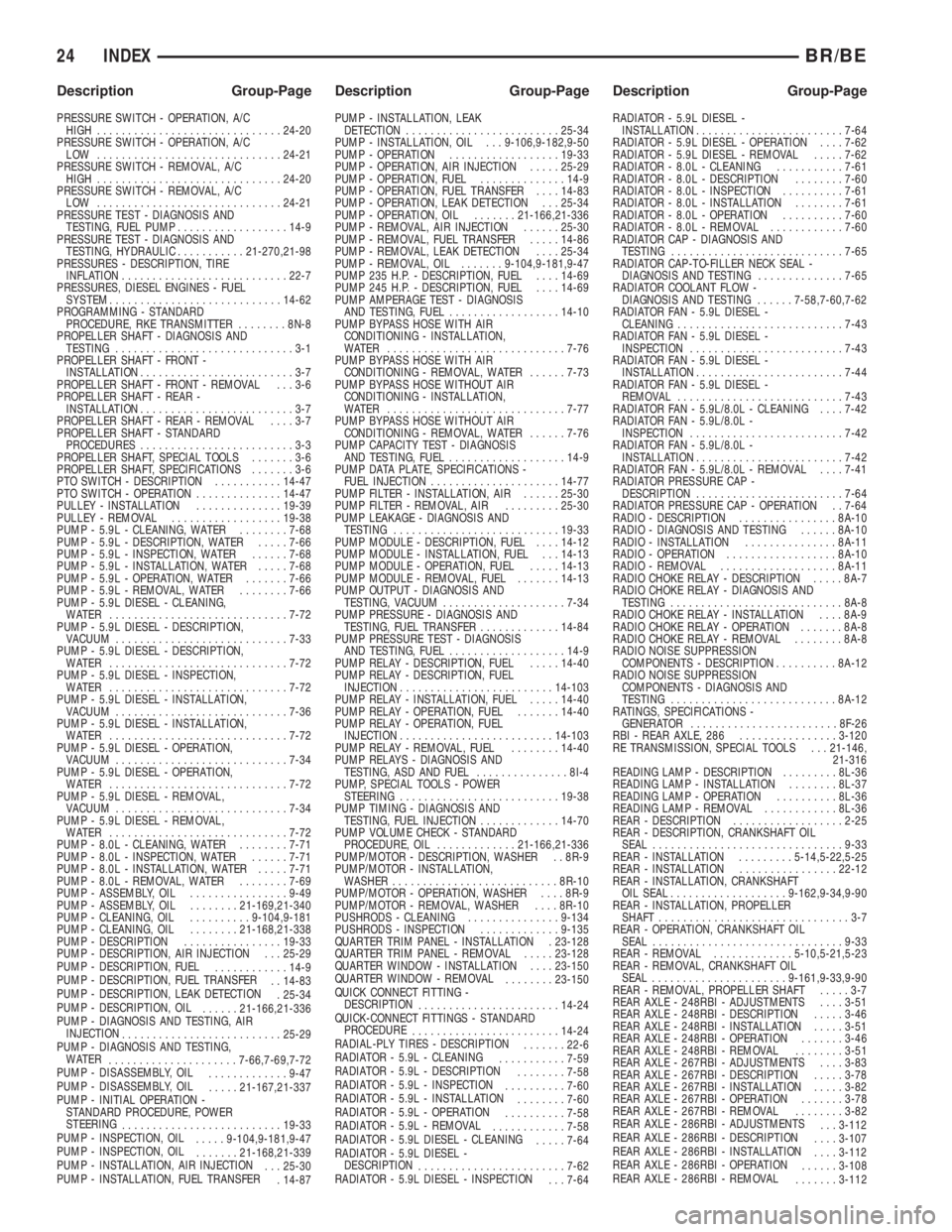
PRESSURE SWITCH - OPERATION, A/C
HIGH..............................24-20
PRESSURE SWITCH - OPERATION, A/C
LOW ..............................24-21
PRESSURE SWITCH - REMOVAL, A/C
HIGH..............................24-20
PRESSURE SWITCH - REMOVAL, A/C
LOW ..............................24-21
PRESSURE TEST - DIAGNOSIS AND
TESTING, FUEL PUMP..................14-9
PRESSURE TEST - DIAGNOSIS AND
TESTING, HYDRAULIC...........21-270,21-98
PRESSURES - DESCRIPTION, TIRE
INFLATION...........................22-7
PRESSURES, DIESEL ENGINES - FUEL
SYSTEM............................14-62
PROGRAMMING - STANDARD
PROCEDURE, RKE TRANSMITTER........8N-8
PROPELLER SHAFT - DIAGNOSIS AND
TESTING.............................3-1
PROPELLER SHAFT - FRONT -
INSTALLATION.........................3-7
PROPELLER SHAFT - FRONT - REMOVAL . . . 3-6
PROPELLER SHAFT - REAR -
INSTALLATION.........................3-7
PROPELLER SHAFT - REAR - REMOVAL....3-7
PROPELLER SHAFT - STANDARD
PROCEDURES.........................3-3
PROPELLER SHAFT, SPECIAL TOOLS.......3-6
PROPELLER SHAFT, SPECIFICATIONS.......3-6
PTO SWITCH - DESCRIPTION...........14-47
PTO SWITCH - OPERATION..............14-47
PULLEY - INSTALLATION..............19-39
PULLEY - REMOVAL..................19-38
PUMP - 5.9L - CLEANING, WATER........7-68
PUMP - 5.9L - DESCRIPTION, WATER.....7-66
PUMP - 5.9L - INSPECTION, WATER......7-68
PUMP - 5.9L - INSTALLATION, WATER.....7-68
PUMP - 5.9L - OPERATION, WATER.......7-66
PUMP - 5.9L - REMOVAL, WATER........7-66
PUMP - 5.9L DIESEL - CLEANING,
WATER .............................7-72
PUMP - 5.9L DIESEL - DESCRIPTION,
VACUUM............................7-33
PUMP - 5.9L DIESEL - DESCRIPTION,
WATER .............................7-72
PUMP - 5.9L DIESEL - INSPECTION,
WATER .............................7-72
PUMP - 5.9L DIESEL - INSTALLATION,
VACUUM............................7-36
PUMP - 5.9L DIESEL - INSTALLATION,
WATER .............................7-72
PUMP - 5.9L DIESEL - OPERATION,
VACUUM............................7-34
PUMP - 5.9L DIESEL - OPERATION,
WATER .............................7-72
PUMP - 5.9L DIESEL - REMOVAL,
VACUUM............................7-34
PUMP - 5.9L DIESEL - REMOVAL,
WATER .............................7-72
PUMP - 8.0L - CLEANING, WATER........7-71
PUMP - 8.0L - INSPECTION, WATER......7-71
PUMP - 8.0L - INSTALLATION, WATER.....7-71
PUMP - 8.0L - REMOVAL, WATER........7-69
PUMP - ASSEMBLY, OIL................9-49
PUMP - ASSEMBLY, OIL........21-169,21-340
PUMP - CLEANING, OIL..........9-104,9-181
PUMP - CLEANING, OIL........21-168,21-338
PUMP - DESCRIPTION................19-33
PUMP - DESCRIPTION, AIR INJECTION . . . 25-29
PUMP - DESCRIPTION, FUEL
............14-9
PUMP - DESCRIPTION, FUEL TRANSFER
. . 14-83
PUMP - DESCRIPTION, LEAK DETECTION
. 25-34
PUMP - DESCRIPTION, OIL
......21-166,21-336
PUMP - DIAGNOSIS AND TESTING, AIR
INJECTION
..........................25-29
PUMP - DIAGNOSIS AND TESTING,
WATER
.....................7-66,7-69,7-72
PUMP - DISASSEMBLY, OIL
.............9-47
PUMP - DISASSEMBLY, OIL
.....21-167,21-337
PUMP - INITIAL OPERATION -
STANDARD PROCEDURE, POWER
STEERING
..........................19-33
PUMP - INSPECTION, OIL
.....9-104,9-181,9-47
PUMP - INSPECTION, OIL
.......21-168,21-339
PUMP - INSTALLATION, AIR INJECTION
. . . 25-30
PUMP - INSTALLATION, FUEL TRANSFER
. 14-87PUMP - INSTALLATION, LEAK
DETECTION.........................25-34
PUMP - INSTALLATION, OIL . . . 9-106,9-182,9-50
PUMP - OPERATION..................19-33
PUMP - OPERATION, AIR INJECTION.....25-29
PUMP - OPERATION, FUEL..............14-9
PUMP - OPERATION, FUEL TRANSFER....14-83
PUMP - OPERATION, LEAK DETECTION . . . 25-34
PUMP - OPERATION, OIL.......21-166,21-336
PUMP - REMOVAL, AIR INJECTION......25-30
PUMP - REMOVAL, FUEL TRANSFER.....14-86
PUMP - REMOVAL, LEAK DETECTION....25-34
PUMP - REMOVAL, OIL.......9-104,9-181,9-47
PUMP 235 H.P. - DESCRIPTION, FUEL....14-69
PUMP 245 H.P. - DESCRIPTION, FUEL....14-69
PUMP AMPERAGE TEST - DIAGNOSIS
AND TESTING, FUEL..................14-10
PUMP BYPASS HOSE WITH AIR
CONDITIONING - INSTALLATION,
WATER .............................7-76
PUMP BYPASS HOSE WITH AIR
CONDITIONING - REMOVAL, WATER......7-73
PUMP BYPASS HOSE WITHOUT AIR
CONDITIONING - INSTALLATION,
WATER .............................7-77
PUMP BYPASS HOSE WITHOUT AIR
CONDITIONING - REMOVAL, WATER......7-76
PUMP CAPACITY TEST - DIAGNOSIS
AND TESTING, FUEL...................14-9
PUMP DATA PLATE, SPECIFICATIONS -
FUEL INJECTION.....................14-77
PUMP FILTER - INSTALLATION, AIR......25-30
PUMP FILTER - REMOVAL, AIR.........25-30
PUMP LEAKAGE - DIAGNOSIS AND
TESTING...........................19-33
PUMP MODULE - DESCRIPTION, FUEL....14-12
PUMP MODULE - INSTALLATION, FUEL . . . 14-13
PUMP MODULE - OPERATION, FUEL.....14-13
PUMP MODULE - REMOVAL, FUEL.......14-13
PUMP OUTPUT - DIAGNOSIS AND
TESTING, VACUUM....................7-34
PUMP PRESSURE - DIAGNOSIS AND
TESTING, FUEL TRANSFER.............14-84
PUMP PRESSURE TEST - DIAGNOSIS
AND TESTING, FUEL...................14-9
PUMP RELAY - DESCRIPTION, FUEL.....14-40
PUMP RELAY - DESCRIPTION, FUEL
INJECTION.........................14-103
PUMP RELAY - INSTALLATION, FUEL.....14-40
PUMP RELAY - OPERATION, FUEL.......14-40
PUMP RELAY - OPERATION, FUEL
INJECTION.........................14-103
PUMP RELAY - REMOVAL, FUEL........14-40
PUMP RELAYS - DIAGNOSIS AND
TESTING, ASD AND FUEL...............8I-4
PUMP, SPECIAL TOOLS - POWER
STEERING..........................19-38
PUMP TIMING - DIAGNOSIS AND
TESTING, FUEL INJECTION.............14-70
PUMP VOLUME CHECK - STANDARD
PROCEDURE, OIL.............21-166,21-336
PUMP/MOTOR - DESCRIPTION, WASHER . . 8R-9
PUMP/MOTOR - INSTALLATION,
WASHER...........................8R-10
PUMP/MOTOR - OPERATION, WASHER....8R-9
PUMP/MOTOR - REMOVAL, WASHER....8R-10
PUSHRODS - CLEANING...............9-134
PUSHRODS - INSPECTION.............9-135
QUARTER TRIM PANEL - INSTALLATION . 23-128
QUARTER TRIM PANEL - REMOVAL.....23-128
QUARTER WINDOW - INSTALLATION....23-150
QUARTER WINDOW - REMOVAL
........23-150
QUICK CONNECT FITTING -
DESCRIPTION
.......................14-24
QUICK-CONNECT FITTINGS - STANDARD
PROCEDURE
........................14-24
RADIAL-PLY TIRES - DESCRIPTION
.......22-6
RADIATOR - 5.9L - CLEANING
...........7-59
RADIATOR - 5.9L - DESCRIPTION
........7-58
RADIATOR - 5.9L - INSPECTION
..........7-60
RADIATOR - 5.9L - INSTALLATION
........7-60
RADIATOR - 5.9L - OPERATION
..........7-58
RADIATOR - 5.9L - REMOVAL
............7-58
RADIATOR - 5.9L DIESEL - CLEANING
.....7-64
RADIATOR - 5.9L DIESEL -
DESCRIPTION
........................7-62
RADIATOR - 5.9L DIESEL - INSPECTION
. . . 7-64RADIATOR - 5.9L DIESEL -
INSTALLATION........................7-64
RADIATOR - 5.9L DIESEL - OPERATION....7-62
RADIATOR - 5.9L DIESEL - REMOVAL.....7-62
RADIATOR - 8.0L - CLEANING...........7-61
RADIATOR - 8.0L - DESCRIPTION........7-60
RADIATOR - 8.0L - INSPECTION..........7-61
RADIATOR - 8.0L - INSTALLATION........7-61
RADIATOR - 8.0L - OPERATION..........7-60
RADIATOR - 8.0L - REMOVAL............7-60
RADIATOR CAP - DIAGNOSIS AND
TESTING............................7-65
RADIATOR CAP-TO-FILLER NECK SEAL -
DIAGNOSIS AND TESTING..............7-65
RADIATOR COOLANT FLOW -
DIAGNOSIS AND TESTING......7-58,7-60,7-62
RADIATOR FAN - 5.9L DIESEL -
CLEANING...........................7-43
RADIATOR FAN - 5.9L DIESEL -
INSPECTION.........................7-43
RADIATOR FAN - 5.9L DIESEL -
INSTALLATION........................7-44
RADIATOR FAN - 5.9L DIESEL -
REMOVAL...........................7-43
RADIATOR FAN - 5.9L/8.0L - CLEANING....7-42
RADIATOR FAN - 5.9L/8.0L -
INSPECTION.........................7-42
RADIATOR FAN - 5.9L/8.0L -
INSTALLATION........................7-42
RADIATOR FAN - 5.9L/8.0L - REMOVAL....7-41
RADIATOR PRESSURE CAP -
DESCRIPTION........................7-64
RADIATOR PRESSURE CAP - OPERATION . . 7-64
RADIO - DESCRIPTION................8A-10
RADIO - DIAGNOSIS AND TESTING......8A-10
RADIO - INSTALLATION...............8A-11
RADIO - OPERATION..................8A-10
RADIO - REMOVAL...................8A-11
RADIO CHOKE RELAY - DESCRIPTION.....8A-7
RADIO CHOKE RELAY - DIAGNOSIS AND
TESTING............................8A-8
RADIO CHOKE RELAY - INSTALLATION....8A-9
RADIO CHOKE RELAY - OPERATION.......8A-8
RADIO CHOKE RELAY - REMOVAL........8A-8
RADIO NOISE SUPPRESSION
COMPONENTS - DESCRIPTION..........8A-12
RADIO NOISE SUPPRESSION
COMPONENTS - DIAGNOSIS AND
TESTING...........................8A-12
RATINGS, SPECIFICATIONS -
GENERATOR........................8F-26
RBI - REAR AXLE, 286................3-120
RE TRANSMISSION, SPECIAL TOOLS . . . 21-146,
21-316
READING LAMP - DESCRIPTION.........8L-36
READING LAMP - INSTALLATION........8L-37
READING LAMP - OPERATION..........8L-36
READING LAMP - REMOVAL............8L-36
REAR - DESCRIPTION..................2-25
REAR - DESCRIPTION, CRANKSHAFT OIL
SEAL...............................9-33
REAR - INSTALLATION.........5-14,5-22,5-25
REAR - INSTALLATION................22-12
REAR - INSTALLATION, CRANKSHAFT
OIL SEAL...................9-162,9-34,9-90
REAR - INSTALLATION, PROPELLER
SHAFT...............................3-7
REAR - OPERATION, CRANKSHAFT OIL
SEAL...............................9-33
REAR - REMOVAL.............5-10,5-21,5-23
REAR - REMOVAL, CRANKSHAFT OIL
SEAL......................9-161,9-33,9-90
REAR - REMOVAL, PROPELLER SHAFT.....3-7
REAR AXLE - 248RBI - ADJUSTMENTS....3-51
REAR AXLE - 248RBI - DESCRIPTION.....3-46
REAR AXLE - 248RBI - INSTALLATION.....3-51
REAR AXLE - 248RBI - OPERATION.......3-46
REAR AXLE - 248RBI - REMOVAL........3-51
REAR AXLE - 267RBI - ADJUSTMENTS....3-83
REAR AXLE - 267RBI - DESCRIPTION.....3-78
REAR AXLE - 267RBI - INSTALLATION.....3-82
REAR AXLE - 267RBI - OPERATION.......3-78
REAR AXLE - 267RBI - REMOVAL........3-82
REAR AXLE - 286RBI - ADJUSTMENTS
. . . 3-112
REAR AXLE - 286RBI - DESCRIPTION
....3-107
REAR AXLE - 286RBI - INSTALLATION
....3-112
REAR AXLE - 286RBI - OPERATION
......3-108
REAR AXLE - 286RBI - REMOVAL
.......3-112
24 INDEXBR/BE
Description Group-Page Description Group-Page Description Group-Page